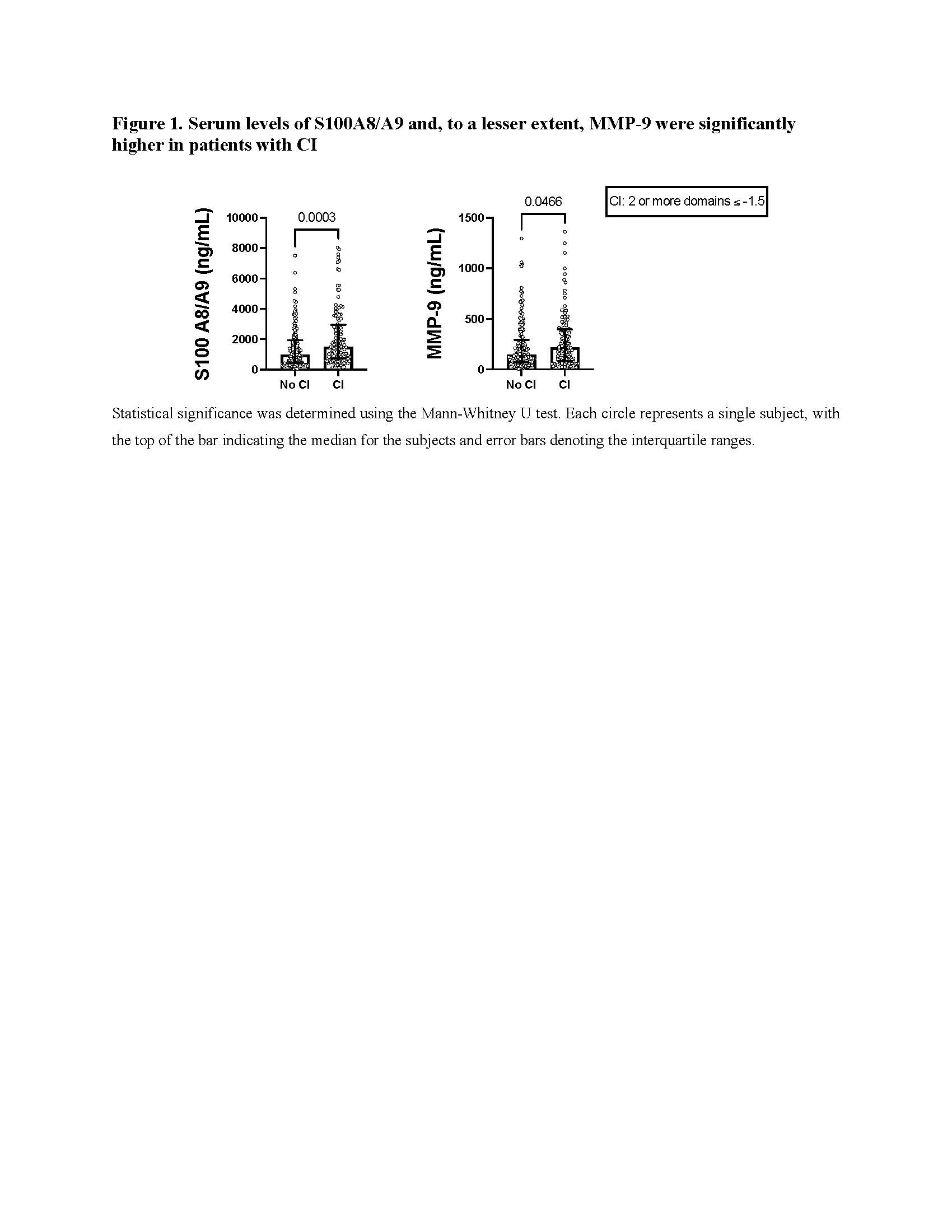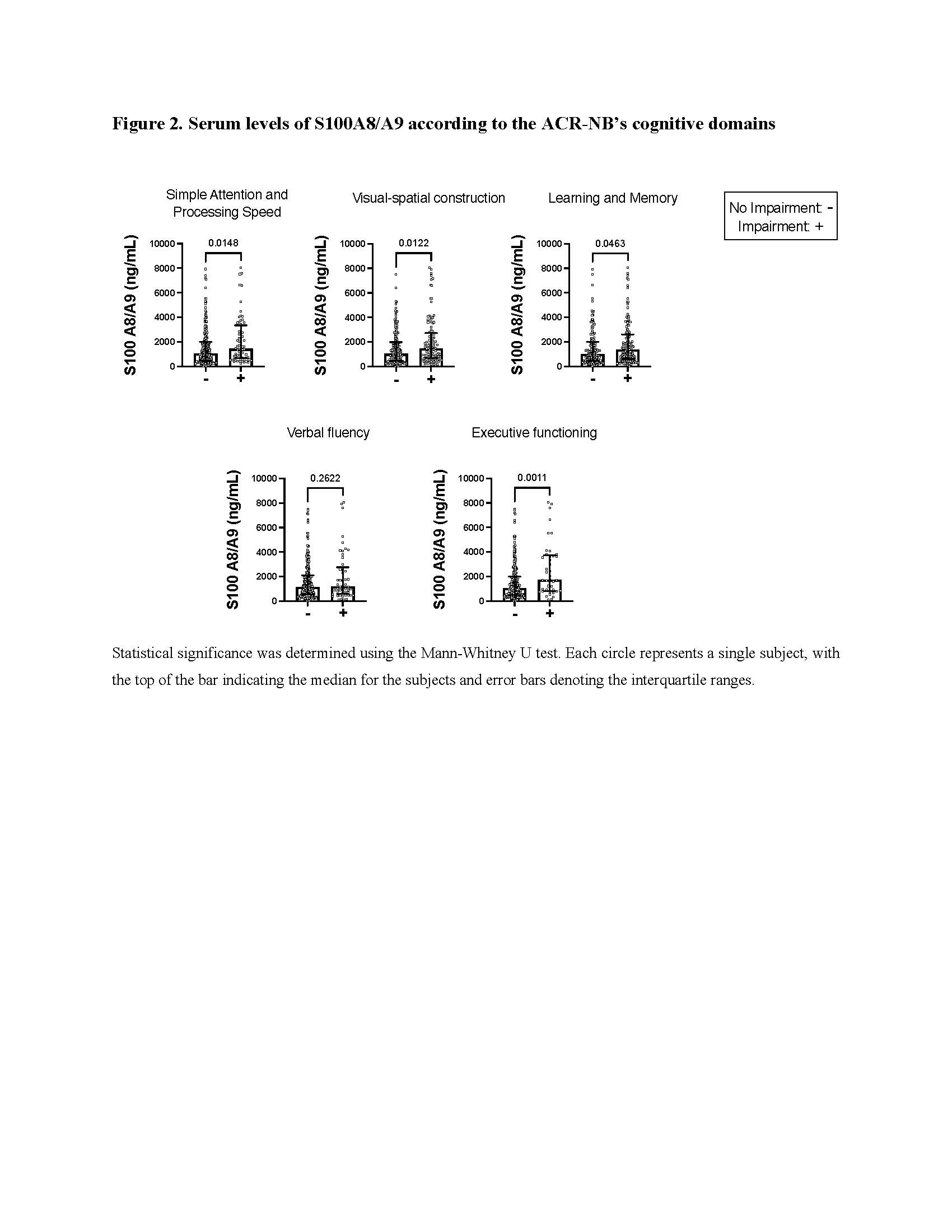Back
Poster Session C
Systemic lupus erythematosus (SLE)
Session: (1440–1485) SLE – Diagnosis, Manifestations, and Outcomes Poster II: Manifestations
1447: Serum Cytokine Profiling Reveals Elevated Levels of S100A8/A9 and MMP-9 in Systemic Lupus Erythematosus Patients with Cognitive Impairment Independently of Disease Activity and Inflammatory Markers
Sunday, November 13, 2022
1:00 PM – 3:00 PM Eastern Time
Location: Virtual Poster Hall
- CM
Carolina Munoz-Grajales, MD
UHN/TWH
Toronto, ON, Canada
Abstract Poster Presenter(s)
Carolina Munoz1, Michelle Barraclough2, Juan Pablo Diaz-Martinez1, Jiandong Su1, Kathleen Bingham3, Mahta Kakvan1, Maria Carmela Tartaglia4, Leslet Ruttan5, May Choi6, Dennisse Bonilla1, Simone Appenzeller7, Patricia Katz8, Dorcas Beaton9, Robin Green5, Joan Wither10 and Zahi Touma1, 1Schroeder Arthritis Institute, Krembil Research Institute, University Health Network and University of Toronto, Toronto, ON, Canada, 2Schroeder Arthritis Institute, Krembil Research Institute, University Health Network, University of Toronto, Centre for Epidemiology Versus Arthritis, Division of Musculoskeletal and Dermatological Sciences, School of Biological Sciences, Faculty of Biology, Medicine and Health, The University of Manchester, NIHR Manchester Biomedical Research Centre, Manchester University NHS Foundation Trust, Manchester Academic Health Science Centre, Toronto, ON, Canada, 3Centre for Mental Health, University Health Network; Department of Psychiatry, University of Toronto, Toronto, ON, Canada, 4University of Toronto Krembil Neurosciences Centre, Toronto, ON, Canada, 5University Health Network-Toronto Rehabilitation Institute, Toronto, ON, Canada, 6Brigham and Women's Hospital | University of Calgary, Calgary, AB, Canada, 7Unicamp, Campinas, São Paulo, Brazil, 8UCSF, San Rafael, CA, 9Institute for Work & Health, Toronto, ON, Canada, 10Schroeder Arthritis Institute, Krembil Research Institute, University Health Network, University of Toronto, Toronto, ON, Canada
Background/Purpose: Cognitive impairment (CI) is one of the most common manifestations of neuropsychiatric lupus(NPSLE), which may occur in the absence of active Systemic Lupus Erythematosus (SLE) and negatively impacts patients' daily functioning and health-related quality of life. Therefore, identifying patients at high risk of developing CI is essential to prevent the accrual of damage and disability. However, its pathogenesis is largely unknown, and currently, biomarkers for the risk of CI are lacking. Here we investigated whether SLE patients with CI have elevated serum levels of cytokines that previous studies have suggested to have a potential pathogenic role in NPSLE.
Methods: 291 individuals between 18-65 years old who met the 2019 EULAR/ACR classification criteria for SLE were included. Cognitive assessment was performed by a psychometrist and included the comprehensive 1-hour ACR Neuropsychological Battery (ACR-NB), which encompasses 19 cognitive tests representing six cognitive domains. The serum levels of nine cytokines (IL-10, IL-6, IFN-g, TNF-a, TWEAK, MMP-9, S100 A8/A9, NGAL, and S100B) were determined using ELISA kits (R&D Systems). Differences in the serum levels of the cytokine profile between patients with and without CI (defined as a z-score of ≤-1.5 in two or more domains in the ACR-NB) were determined by the Mann-Whitney U test. Correlations were assessed using Spearman's rank correlation coefficient and the association of the different cytokine levels with each CI test score by logistic regression.
Results: Forty percent of the patients (n=116) had CI. While no differences in the demographic characteristics and disease activity were observed between patients with and without CI, serum levels of S100A8/A9 and, to a lesser extent, MMP-9 were significantly higher in patients with CI (Figure 1). When the ACR-NB's domains were examined individually, patients with impaired simple attention and processing; visual-spatial construction; learning and memory; or executive function also had significantly higher S100A8/A9 than those without impairment (Figure 2). Indicative of probable collinearity, S100A8/A9 and MMP-9 moderately correlated with each other (Rho=0.52, p< 0.0001) and both correlated with NGAL (Rho=0.64, p< 0.0001; Rho=0.56, p< 0.0001, respectively). S100A8/A9 had the strongest relationship with multiple CI tests by logistic regression. The serum levels of S100A8/A9 and MMP-9 did not correlate with TNF-a, IL-6, hs-CRP, or disease activity as determined by the SLE Disease Activity Index-2000 (SLEDAI-2K).
Conclusion: Among the multiple cytokines measured, only the heterodimer of the calcium-binding proteins S100A8 and S100A9 and MMP-9 were found to be increased in SLE patients with CI. The lack of correlation with the levels of other pro-inflammatory markers and its differential association with distinct cognitive domains may indicate that, in the setting of CI, S100A8/A9 mediates a regional neuroinflammatory response rather than systemic pro-inflammation. These results open new avenues to study the role of S100A8/A9 and MMP-9 in CI in adults with SLE.
 Figure 1. Serum levels of S100A8/A9 and, to a lesser extent, MMP-9 were significantly higher in patients with CI
Figure 1. Serum levels of S100A8/A9 and, to a lesser extent, MMP-9 were significantly higher in patients with CI
 Figure 2. Serum levels of S100A8/A9 according to the ACR-NB’s cognitive domains
Figure 2. Serum levels of S100A8/A9 according to the ACR-NB’s cognitive domains
Disclosures: C. Munoz, None; M. Barraclough, None; J. Diaz-Martinez, None; J. Su, None; K. Bingham, None; M. Kakvan, None; M. Tartaglia, None; L. Ruttan, None; M. Choi, AstraZeneca, MitogenDx, mallinckrodt, Janssen, AbbVie/Abbott, Alimentiv, Amgen, AVIR Pharma Inc, BioJAMP, Bristol-Myers Squibb(BMS), Celltrion, Ferring, Fresenius Kabi, McKesson, Mylan, Takeda, Pendopharm, Pfizer, Roche; D. Bonilla, None; S. Appenzeller, None; P. Katz, None; D. Beaton, None; R. Green, None; J. Wither, AstraZeneca, Pfizer; Z. Touma, None.
Background/Purpose: Cognitive impairment (CI) is one of the most common manifestations of neuropsychiatric lupus(NPSLE), which may occur in the absence of active Systemic Lupus Erythematosus (SLE) and negatively impacts patients' daily functioning and health-related quality of life. Therefore, identifying patients at high risk of developing CI is essential to prevent the accrual of damage and disability. However, its pathogenesis is largely unknown, and currently, biomarkers for the risk of CI are lacking. Here we investigated whether SLE patients with CI have elevated serum levels of cytokines that previous studies have suggested to have a potential pathogenic role in NPSLE.
Methods: 291 individuals between 18-65 years old who met the 2019 EULAR/ACR classification criteria for SLE were included. Cognitive assessment was performed by a psychometrist and included the comprehensive 1-hour ACR Neuropsychological Battery (ACR-NB), which encompasses 19 cognitive tests representing six cognitive domains. The serum levels of nine cytokines (IL-10, IL-6, IFN-g, TNF-a, TWEAK, MMP-9, S100 A8/A9, NGAL, and S100B) were determined using ELISA kits (R&D Systems). Differences in the serum levels of the cytokine profile between patients with and without CI (defined as a z-score of ≤-1.5 in two or more domains in the ACR-NB) were determined by the Mann-Whitney U test. Correlations were assessed using Spearman's rank correlation coefficient and the association of the different cytokine levels with each CI test score by logistic regression.
Results: Forty percent of the patients (n=116) had CI. While no differences in the demographic characteristics and disease activity were observed between patients with and without CI, serum levels of S100A8/A9 and, to a lesser extent, MMP-9 were significantly higher in patients with CI (Figure 1). When the ACR-NB's domains were examined individually, patients with impaired simple attention and processing; visual-spatial construction; learning and memory; or executive function also had significantly higher S100A8/A9 than those without impairment (Figure 2). Indicative of probable collinearity, S100A8/A9 and MMP-9 moderately correlated with each other (Rho=0.52, p< 0.0001) and both correlated with NGAL (Rho=0.64, p< 0.0001; Rho=0.56, p< 0.0001, respectively). S100A8/A9 had the strongest relationship with multiple CI tests by logistic regression. The serum levels of S100A8/A9 and MMP-9 did not correlate with TNF-a, IL-6, hs-CRP, or disease activity as determined by the SLE Disease Activity Index-2000 (SLEDAI-2K).
Conclusion: Among the multiple cytokines measured, only the heterodimer of the calcium-binding proteins S100A8 and S100A9 and MMP-9 were found to be increased in SLE patients with CI. The lack of correlation with the levels of other pro-inflammatory markers and its differential association with distinct cognitive domains may indicate that, in the setting of CI, S100A8/A9 mediates a regional neuroinflammatory response rather than systemic pro-inflammation. These results open new avenues to study the role of S100A8/A9 and MMP-9 in CI in adults with SLE.
 Figure 1. Serum levels of S100A8/A9 and, to a lesser extent, MMP-9 were significantly higher in patients with CI
Figure 1. Serum levels of S100A8/A9 and, to a lesser extent, MMP-9 were significantly higher in patients with CI Figure 2. Serum levels of S100A8/A9 according to the ACR-NB’s cognitive domains
Figure 2. Serum levels of S100A8/A9 according to the ACR-NB’s cognitive domains Disclosures: C. Munoz, None; M. Barraclough, None; J. Diaz-Martinez, None; J. Su, None; K. Bingham, None; M. Kakvan, None; M. Tartaglia, None; L. Ruttan, None; M. Choi, AstraZeneca, MitogenDx, mallinckrodt, Janssen, AbbVie/Abbott, Alimentiv, Amgen, AVIR Pharma Inc, BioJAMP, Bristol-Myers Squibb(BMS), Celltrion, Ferring, Fresenius Kabi, McKesson, Mylan, Takeda, Pendopharm, Pfizer, Roche; D. Bonilla, None; S. Appenzeller, None; P. Katz, None; D. Beaton, None; R. Green, None; J. Wither, AstraZeneca, Pfizer; Z. Touma, None.

